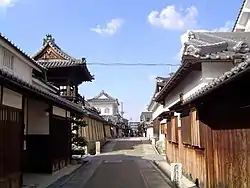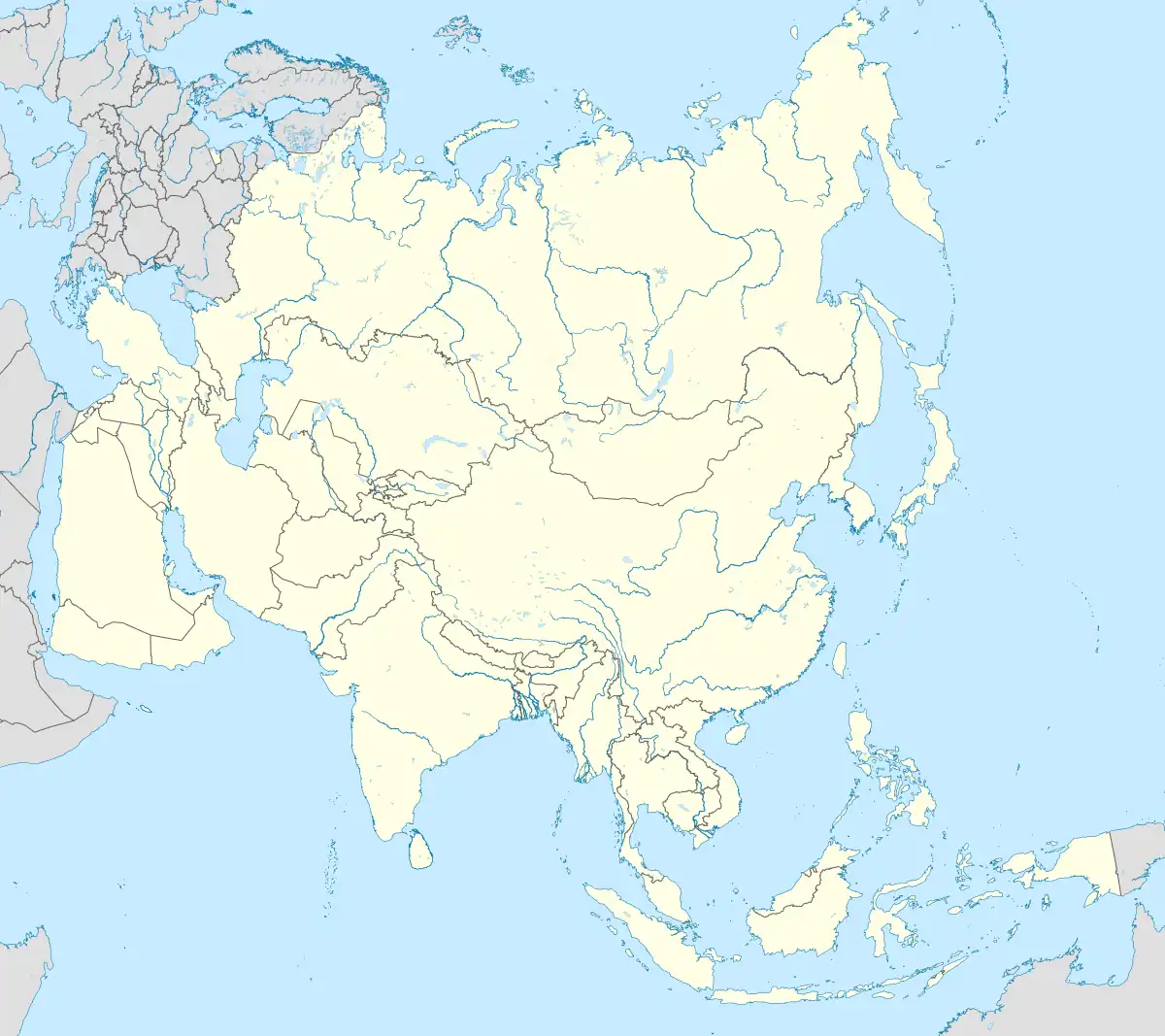Tondabayashi-shi Tondabayashi[1]
富田林市富田林 | |
|---|---|
Important Preservation District for Groups of Traditional Buildings | |
 城之門筋(Jonomon-street) | |
| Coordinates: 34°30′1.181″N 135°36′9.900″E / 34.50032806°N 135.60275000°E | |
| Country | Japan |
| Region | Kansai |
| Prefecture | Osaka |
| Municipal | Tondabayashi |
| Purchased of land | about 1558 |
| Founded by | Shoshu, the 16th chief priest of Kosho-ji temple |
| Area | |
| • Total | 0.129 km2 (0.050 sq mi) |
| Highest elevation | 67 m (220 ft) |
| Lowest elevation | 64 m (210 ft) |
Tondabayashi Jinaimachi (富田林寺内町) is a popular name of the old temple-based town (Jinaimachi) located in Tondabayashi City, Osaka Prefecture, Japan. It is one of the Important Preservation Districts for Groups of Traditional Buildings (1997) in Tondabayashi-shi Tondabayashi (富田林市富田林重要伝統的建造物群保存地区).[1] The town retains town blocks from the Sengoku period, along with machiyas (traditional wooden town residences) built from the mid-Edo period on.[2][3]
Geography
Tondabayashi Jinaimachi is located at the center of the city, on a fluvial terrace at left bank of the Ishi river and the midstream.[4] Most of the old town area falls within the jurisdiction of Tondabayashi-cho (富田林町); the rest of the area is in Hon-machi (本町). Tondabayashi-cho adheres to the old town since the Edo period.
The town has an area of 12.9 hectares.[3] It was formed in an ellipsoidal form, measuring 400m from east to west and 350m from north to south.[4] The town layout was designed with a grid plan, which consists of six streets in a north–south direction and seven streets in an east–west direction. There are 25 quadrilateral town blocks in the center, and 16 irregular town blocks on the outer edge.[5]
The relative elevation is about 10m from the river to the town.[4] It used a natural terrace cliff to construct the earthworks (土居, doi) with bamboo groves at the eastern, southern and western edge of the town, and the dug-out moat (堀割, horiwari) at the northern edge.[5]
History
About 1558 (Eiroku 1), Kosho-ji temple obtained a wasteland of the Tonda (富田) for temple grounds. Kosho-ji temple cooperated with eight headmen (八人衆) to construct a branch temple, town blocks, residences and dry fields. They changed the name of Jinaimachi to Tondabayashi (富田林).[6]
In the Sengoku period, Kosho-ji branch temple (興正寺別院) and Jinaimachi were granted privileges and immunities by authorities.[7] The town people governed autonomously against a background of religious authority of Kosho-ji temple.[7]
Over the Edo period, the town forfeited its privileges and immunities. In the early Edo period, the town was developed as Zaigoumachi (在郷町, merchant town in the countryside).[8] Many people came from the surrounding villages and the town prospered with merchants offering lumber, cotton, rapeseed oil, and sake.[8]
After the Meiji Restoration, the town continued to prosper as the political and commercial center of southern Kawachi.[9] From the latter Meiji period onward, the town headed gradually into a decline due to the opening of the railway, land reform, and motorization.[10] As a result, it was left out of postwar development.[11]
Traditional buildings
Temples
- Kosho-ji branch temple
- Myokei-ji temple
- Jokoku-ji temple
Machiyas
- Old Sugiyama family residence
- Nakamura family residence
Modern architectures
- Nakauchi ophthalmic clinic
Notable people
- Tsuyuko Isonokami
See also
References
- 1 2 3 4 5 6 7 全国伝統的建造物群保存地区協議会 2017, p. 34.
- ↑ 富田林興正寺別院 2012, p. 14.
- 1 2 富田林市 2018.
- 1 2 3 富田林興正寺別院 2012, p. 19.
- 1 2 富田林市 1984, p. 10.
- ↑ 富田林市 1984, p. 6.
- 1 2 富田林市教育委員会 1999, p. 7.
- 1 2 富田林市教育委員会 1999, p. 9.
- ↑ 富田林市教育委員会 1999, p. 12.
- ↑ 富田林市教育委員会 1999, p. 13.
- ↑ 富田林市教 1987, p. 12.
External links
- 富田林興正寺別院 (2012). 富田林興正寺別院伽藍総合調査報告書 (in Japanese).
- 富田林市 (1984). 富田林寺内町 歴史的町並み保全計画調査報告書 (in Japanese).
- 富田林市教育委員会 (1999). 富田林寺内町ガイド じないまち探究誌 (in Japanese).
- 全国伝統的建造物群保存地区協議会 (2017). 伝統的建造物群保存地区 歴史の町並 (in Japanese).
- 富田林市 (1987). 重要文化財 旧杉山家住宅修理工事報告書 (in Japanese).
- Tondabayashi City Boards of Education. Tondabayashi Jinai-machi Walking Tour Map.
- 富田林市 (May 18, 2018). "重要伝統的建造物群保存地区の追加選定について". Retrieved June 7, 2018.


